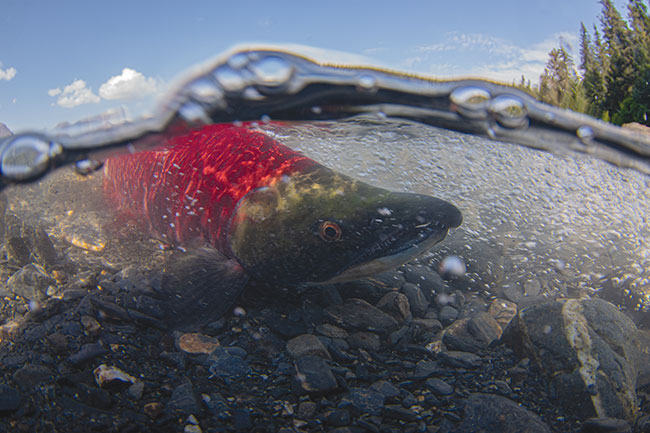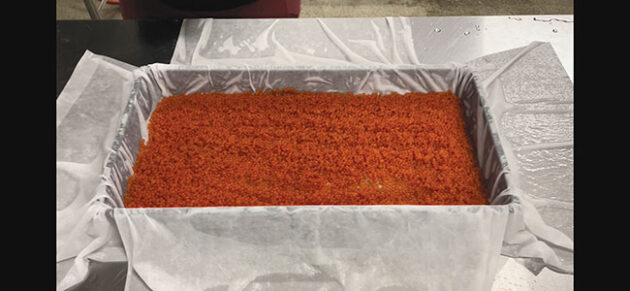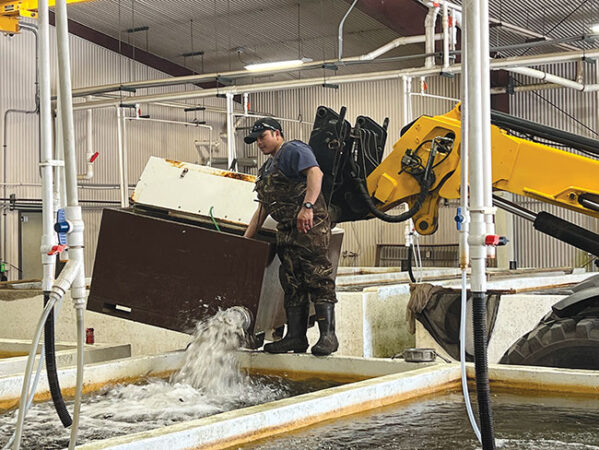
Features
Fish handling
Hatchery Operations
Charting the fish’s journey from egg to plate
July 27, 2023 By Nancy Erickson
 In preparation for shipping, fertile trout eggs are wrapped in wet cloth, packed in trays and stacked in coolers with ice packs before sealing and sent on their way.
Photo: Riverence Brood LLC
In preparation for shipping, fertile trout eggs are wrapped in wet cloth, packed in trays and stacked in coolers with ice packs before sealing and sent on their way.
Photo: Riverence Brood LLC Most people think of how to properly cook their freshly-caught fish when hearing the term “fish handling.” But that term takes on a whole new meaning when presented to hatchery workers raising everything from wild salmon to baitfish to ornamental species.
I talked with several individuals across the U.S. regarding challenges of rearing different fish species – from spawning to sale or release – and methods used to insure fish safely arrive wherever that destination might be.
From egg to plate
Jesse Trushenski is the chief science officer for the Riverence Group, a family of land-based farms that are the largest producer of farmed rainbow trout and steelhead in the Americas, with operations based in Washington and Idaho. Riverence is also the only commercial supplier of Atlantic salmon and Coho salmon eggs located in the U.S.
The company ships Atlantic salmon, steelhead and Coho fertilized eggs worldwide from their Washington facility. Eggs are also safely transported to their growout farms, located along the Snake River in Idaho, where they are hatched and raised for consumers.
“It’s always best to be moving eggs rather than moving fish if you’re doing transport across jurisdictions or across long distances, because you can disinfect those eggs when you receive them to make sure there is nothing on the outside of the eggs,” Trushenski said.
Eggs are shipped in coolers wrapped in moist towels with ice to keep the cold inside the coolers, she said. Even though no water is involved, shipping has its challenges.
Riverence works with a company that helps manage logistics. One of the biggest limiting factors for a successful arrival of product is insuring all accompanying paperwork is in place, both on the shipping and receiving end.
“As you can imagine when you’re shipping a live product, there’s a lot of fish health verifications that have to go with that to prove your fish are clean and healthy,” said Trushenski. “So making sure that info is in the hands of the people that need to review it and approve it on the receiving end – that’s a perennial challenge.”

A sockeye salmon languishes in the shallow waters of a small lake it was released into after being reared at the Trail Lakes Hatchery.
Photo: Kenny Regan
Easy on the eyes
They may not be anywhere near the size of a salmon, but rearing ornamental fish presents another side to the fish handling story.
Eric Wagner is the owner of Proaquatix LLC, a top-rated ornamental fish farm and wholesaler of captive-bred clown fish and other marine ornamentals. The Florida-based firm produces more than 40 species of marine ornamentals and sells to distributors, retail stores and public aquariums all over the world.
Ideally, Proaquatix fish are only moved and handled a couple of times before leaving the farm, Wagner said.
“Fish handling always adds stress and can amplify existing issues,” said Wagner. “Unlike a food fish farm, we don’t need to continually sort our fish by size to maintain ideal culture scenarios. Our fish do need to be carefully inspected and sorted before sale and this is always done by hand. We do our best to minimize handling and maintain the healthiest fish.”
Nets are used to capture the fish, which are then placed in floating baskets for sorting. Every handheld fish is flipped over to check for deformities and examine the pattern.
Proaquatix ships via UPS domestically and airline cargo for international destinations.
The fish are shipped in plastic bags holding one third water and two-thirds oxygen in Styrofoam coolers with a cardboard shell, inscribed with handling instructions including desired temperature and content descriptions.
“There are unique challenges for each destination that can change with the time of year,” said Wagner. “We generally pack for a 48-hour transit – although it is usually less than 24 – and add heat or cold packs accordingly.”
Wagner said planning for the ship-out and destination conditions is the easy part, with little control over the transit.
“UPS and our airlines generally take good care of our fish, but there can be unforeseen challenges at times,” he added. “Blizzards and severe cold are the most troublesome. There have been a couple of occasions where an airline worker put our fish in the freezer section of the plane, thinking they were frozen food-fish.”
Rise and shine
Everyone gets excited when it’s springtime in Alaska – even sockeye salmon eggs that have hatched over the winter and lay snuggled in their substrate beds at the Trail Lakes Hatchery on the shores of Upper Trail Lake outside Moose Pass in the southcentral part of the state.
It’s time for the juvenile salmon to move outside.
Brett Jenkins is hatchery operations manager for Cook Inlet Aquaculture Association, one of five regional associations throughout Alaska responsible for the protection of self-sustaining salmon stocks and rehabilitation of those stocks and their habitat for use by personal, sport, subsistence and commercial users.
During the summer and fall, hatchery staff collect salmon eggs, fertilize them and put them in incubators where they remain until early spring. The salmon are raised in the hatchery until they reach the size as fry or smolt and then either seeded into lakes or released to the ocean to complete their lifecycle.
Fish are transported by truck, boat and floatplane.
“Smolt are definitely easier to transport than fry, because smolt are larger and more robust and can tolerate more handling,” said Jenkins. “We are also able to run aerators in our transport tanks with smolt that cannot be used with fry as they are often too small and can slip through the aerator screens, resulting in mortality. Aerators help manage saturated gasses in the water, making longer transports easier to manage than those without aeration.”
Bigger challenges involve distances fish are transported and weather they encounter.
“Tides are another factor for our fish transports that take place by boat, as they impact access to some of our locations,” Jenkins added. “Proper planning and density management of the transport tanks are the keys to our success.”

Baitfish are drained from a tractor tank into warehouse runways after being seined from outside ponds. The fish will be sized, measured into barrels and loaded onto transport trucks, headed to market. Photo: Ben Gollon
Fish on!
Many fish bites if you got good bait, goes a line in the song sung by Taj Mahal.
Gollon Bros. Wholesale Live Bait has been at the forefront of the North American Live Bait industry for more than a century.
Located in Stevens Point, Wisc., the family-owned business is one of the few baitfish wholesalers to have direct experience in farm-raising minnows, importing/exporting, and harvesting direct from the wild.
“Baitfish are harder to handle than your normal trout, salmon or walleyes,” said company president, Ben Gollon. “They’re not as strong as far as holding up to mechanical handling; a lot more challenging and they’re small – one-to-five inches at most.”
“My feelings are every time a fish touches a net, its harmful to them. Their scales and slime coat come off,” Gollon said. “Our main tool is a five gallon bucket.”
Bait size is important. Rather than using the industry-popular grading boxes, Gollon Bros. uses panel graders that do not require fish to be handled manually, but allows them to simply swim through on their own, reducing stress, Gollon said.
The panel graders also help detect trash fish that can end up mixed in with baitfish in outside ponds, often deposited there by birds. And that’s a challenge when transporting minnows across state lines – there’s regulations against it, said Gollon.
The company has a large fleet of trucks equipped with fish transport tanks and oxygen, but that also presents challenges during long hauls when drivers are only allowed to drive 11 hours a day, Gollon said.
“You can’t sit with a load of fish,” he said. “You have to put two drivers on or figure something out.”
Anglers are picky and being able to supply the right baitfish at the right time is crucial.
As an example, “There’s a perch run in Lake Erie that, if they don’t have the right kind of minnow, they won’t go,” said Gollon of participants.
“You try to do everything right,” he added.
Print this page
Advertisement
- French study finds advantages in lowering incubation temp in European seabass eggs
- Shrimp Summit takes deep dive into industry challenges





